by Jeanine Basinger WINTER 2009/10
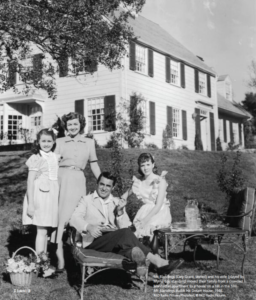 When I was growing up on the midwestern prairie, I had a clear image of the state of Connecticut. I knew what kind of people lived there and what sort of houses they lived in. Connecticut was a world of leafy backroads, quaint villages, and comfortable country homes. I got this idea from the same place I got most of my ideas: the movies. In the Hollywood films of the 1930s, ‘ 40s, and ‘50s, Connecticut was very important. When stylish New Yorkers needed to get married in a rush, they drove up to Greenwich, and when they tried out their new plays, they went to New Haven. When they needed a respite from their glamorous careers, they visited people in Cos Cob who gave lavish weekend parties. When they needed a good place to live after the kids arrived, they moved to Westport so the women could drive “woody” station wagons down to the train station to pick up their husbands, who wore grey flannel suits and worked in advertising.
When I was growing up on the midwestern prairie, I had a clear image of the state of Connecticut. I knew what kind of people lived there and what sort of houses they lived in. Connecticut was a world of leafy backroads, quaint villages, and comfortable country homes. I got this idea from the same place I got most of my ideas: the movies. In the Hollywood films of the 1930s, ‘ 40s, and ‘50s, Connecticut was very important. When stylish New Yorkers needed to get married in a rush, they drove up to Greenwich, and when they tried out their new plays, they went to New Haven. When they needed a respite from their glamorous careers, they visited people in Cos Cob who gave lavish weekend parties. When they needed a good place to live after the kids arrived, they moved to Westport so the women could drive “woody” station wagons down to the train station to pick up their husbands, who wore grey flannel suits and worked in advertising.
Whether Connecticut was a bedroom for Manhattan, a weekend retreat, or a suburb an homestead, however, it always had one thing going for it: great houses.
I liked what I saw. It was “my” Connecticut, a place very specifically designed by the movies. I thought it would be great to live in one of those “typical” Connecticut homes. Some were cozy, as in Claudia and David (1946). Others were large and rambling, so big they could be converted in to successful night clubs (Holiday Inn, 1942). Many were architecturally inventive, with gourmet kitchens and living rooms to hold the world’s largest Christmas tree (Christmas in Connecticut, 1945). And I wasn’t worried about money, because you could apparently buy a dilapidated old house, tear it down, and build a new one on top of it for u n d e r $ 2 5 , 0 0 0 . (That’s what Cary Grant and Myrna Loy did in Mr. Blandings Builds His Dream House, 1948.)
Connecticut’s movie homes came in two basic types: rustic but upscale Colonial, or architecturally modern, which identified the dwellers as those newest, most relevant of Americans—the suburbanites. The Colonial versions had half-doors, wainscoted dining rooms, built-inch in a cabinets, window seats, hardwood floors, and gigantic kitchens with big wooden tables in the middle. There was a plethora of fire places—in the kitchen, the master bedroom, the dining room, and the main living room. All of them were made out of gigantic stones, and no one ever had a problem lighting a fire in them. These houses were decorated with canopied beds, cozy furniture covered in chintz, busy wallpapers, pewter tankards, fringed lampshades, and old dishes hanging on the wall. (Didn’t any of those plates ever fall down?) There were little niches in the walls for the telephones to sit in. I loved those phone niches—and I wanted one. When you drove up to the front door of one of these beauties (presumably in your very own “woody”), you might see white columns or maybe a flagstone entry way or perhaps even a picturesque barn out back. There were flowers lining the walkways and fencing to mark the property boundaries. The lawns were impeccably landscaped. A home like this can be seen when Katharine Hepburn and Cary Grant (and a leopard on a leash) drive out to visit her aunt in Connecticut (Bringing Up Baby, 1938). Lucy and Desi—that is, Mr. and Mrs. Ricky Ricardo —moved in to such a place in Westport on their 1950s television show.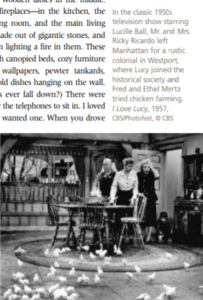
The postwar shift to the suburbs inspired the more modern version of the “typical” Connecticut home. These newer houses had car ports and maintenance-free landscaping. Inside, everything was usually on one floor, with an open layout in which the living room, dining room, and kitchen flowed seamlessly together. The entry way was marked off by skinny decorative poles, which have always dumbfounded me. (If those weak-looking poles were knocked over, say by my rampaging nephews, would the roof fall down?) A long corridor led down the hall to various bedrooms, and the master had its own roomy bathroom with a built-in dressing table for the wife of the house. There were pull-down lamps over the dining table, patios for barbecuing, possibly a swimming pool (the California touch), plenty of Scandinavian furniture, and the inevitable stone fireplace that reached dramatically to the ceiling, with a matching stone hearth. (Whenever Hollywood presented Connecticut homes, new or old, Colonial or modern, there was stonework everywhere, both inside and out. What was the deal with all that stone? Where I was raised, on rich farm land, we knew those stones for what they were: a bunch of rocks.
Connecticut’s most celebrated acting couple, Paul Newman and Joanne Woodward, lived in an example of the modern dream house in a 1958 comedy about suburban life, Rally Round the Flag, Boys. Their home had a flat roof, the now-required TV set, an open staircase and floor plan, tons of Danish furniture, and every possible kitchen appliance, including a wall oven into which Woodward pops TV dinners. (I am partial to a glimpse of Rosenthal china that viewers can see from time to time residing splendidly in their china cabinet.) In this film, based on a book by humorist Max Shulman, Rally’s world is located “in New England…ninety miles north from New York City” in “Putnam’s Landing.” Newman and Woodward play a married couple (what a stretch). He commutes by train into New York for his job in public relations. She runs their home and is in turn run ragged by their two sons. To get out of the house and validate her worth, she joins committee after committee. (All the wives are at loose ends and on the loose. Their neighbor, played by a young Joan Collins, has time to chase Paul Newman around her living room because her own husband is on the road pursuing the American dream of wealth.)
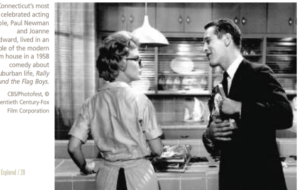 From 1930 to the mid-1960s, when Hollywood presented a “typical” Connecticut home, the architecture was always elegant, reflecting good taste and quality. Even when the family was decidedly middle-class, as in the 1936 filmed version of Eugene O’Neill’s “Ah, Wilderness!” or its musical remake (Summer Holiday, 1948), the New London, Connecticut home of the family was large, well appointed, and comfortable. Any such home would have been beyond the reach of most young couples in real life. An exception might be the dark and dated Victorian mansion in South Bay that Jennifer Jones and Gregory Peck move into in The Man in the Grey Flannel Suit (1956). It’s referred to as “one of the few houses in Connecticut that hasn’t grown old gracefully.” (They inherit it, and they’re financially strapped.)
From 1930 to the mid-1960s, when Hollywood presented a “typical” Connecticut home, the architecture was always elegant, reflecting good taste and quality. Even when the family was decidedly middle-class, as in the 1936 filmed version of Eugene O’Neill’s “Ah, Wilderness!” or its musical remake (Summer Holiday, 1948), the New London, Connecticut home of the family was large, well appointed, and comfortable. Any such home would have been beyond the reach of most young couples in real life. An exception might be the dark and dated Victorian mansion in South Bay that Jennifer Jones and Gregory Peck move into in The Man in the Grey Flannel Suit (1956). It’s referred to as “one of the few houses in Connecticut that hasn’t grown old gracefully.” (They inherit it, and they’re financially strapped.)
One of the first movies to go out into the real streets of Connecticut for location shooting was Elia Kazan’s 1947 police drama Boomerang!. Kazan, who maintained a home in Connecticut for years, was an admirer of Italian neo-realism, and he took his camera, crew, and actors directly into the streets where the story actually happened. Boomerang! was based on the real-life murder of a Connecticut priest for which an innocent man was arrested. Kazan wanted his movie to have all the hard-nosed reality that the story required. He especially wanted the setting to come alive, so he went to Connecticut locations, using churches, diners, police stations, and working men’s houses to create the authentic atmosphere he wanted to capture. He also used Connecticut residents in minor roles and as background in street scenes. (Keeneyed movie-goers love spotting Kazan’s frequent collaborator and fellow state resident Arthur Miller doing a cameo in a police lineup.) The result was not an escapist Connecticut, but an honest look at the urban—not suburban—aspect of the state.
The news that Connecticut wasn’t all beautiful homes was further conveyed by Parrish, a successful soap opera 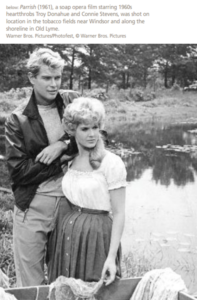 film of 1961. Audiences saw the open fields of the Connecticut River valley, with day workers hand-picking tobacco and moving it into barns for drying. Parrish was shot on location in Windsor and also along the shoreline in Old Lyme. Starring Claudette Colbert in her final theatrical filmed release and the heartthrob-of-theday Troy Donahue, Parrish showed tobacco workers living in less-thanColonial conditions but kept the tradition of the typically “lovely Connecticut home” for the house lived in by the tobacco czar, Karl Malden. Covered bridges, seaside hotels, leafy lanes, and expensive sailboats—all real—were also seen in Parrish, a landmark film for Connecticut, one of the first to translate the state into a varied location.
film of 1961. Audiences saw the open fields of the Connecticut River valley, with day workers hand-picking tobacco and moving it into barns for drying. Parrish was shot on location in Windsor and also along the shoreline in Old Lyme. Starring Claudette Colbert in her final theatrical filmed release and the heartthrob-of-theday Troy Donahue, Parrish showed tobacco workers living in less-thanColonial conditions but kept the tradition of the typically “lovely Connecticut home” for the house lived in by the tobacco czar, Karl Malden. Covered bridges, seaside hotels, leafy lanes, and expensive sailboats—all real—were also seen in Parrish, a landmark film for Connecticut, one of the first to translate the state into a varied location.
By 1980, very few films were shot totally inside a studio. Connecticut soon began to feel the impact of “real” location film-making. In 1988, the charming romantic comedy Mystic Pizza was filmed on location using the Mystic Pizza parlor at 55 West Main Street in Mystic. The film featured the luminous Julia Roberts in a star-making role and was also the film debut of Matt Damon. An unexpected hit, Mystic Pizza turned a small Connecticut business into a national icon. Tourists (as well as locals) made buying a slice at Mystic Pizza into a glamorous event, resulting in lengthy customer lines and a great many stolen mementoes disappearing regularly from the shop. Jane Fonda and Robert DeNiro came to Waterbury to film Stanley and Iris (1990), in which DeNiro played an illiterate dish washer. Waterbury was chosen as a setting because the filmmakers wanted an authentic-looking factory town, and on-screen everything worked perfectly. Off-screen, however, large numbers of Vietnam veterans showed up to protest Fonda’s appearance (because of her vocal anti-war stance decades earlier).
Movies like Mystic Pizza and Stanley and Iris presented a lesser-known image of Connecticut. However, the state’s lovely homes and gardens continued to be used as “typical.” Connecticut had become the definition of the suburban dream life, so it was inevitable that movies would begin to question the validity of the concept. The Stepford Wives (1975) was shot partly on location in Darien. It was a weird sci-fi story about the “perfection” of the suburbs: beautiful wives, beautiful kids, beautiful homes that apparently never got dirty. This “perfection” had a slightly mechanical quality to it because it had been achieved by a creepy men’s club that had made a pact with a modern devil. Their wives were turned into robots. They would never age, never talk back, never complain, and always cook, shop, clean house, and be ready for sex. As the advertising poster put it, “Something strange is happening in the town of Stepford.” The Stepford Wives was remade in 2004, starring Nicole Kidman and shot on location in Norwalk, Darien, and New Canaan, still using that same ad line. (Something strange was happening to “my” Connecticut’s image of perfection.)
An example of a modern film that questions the “dream home” idea of Connecticut is 2008’s Revolutionary Road. Shot all over the state (in Beacon Falls, Thomaston, Norwalk, Bethel, Shelton, Darien, Fairfield, Redding, Greenwich, New Canaan, the Pinewood Lake in Trumbull, the Dolan Middle School in Stamford, and elsewhere), Revolutionary Road was based on a respected novel written by Richard Yates. The story is set in the 1950s, and it is a direct attack on the idea that a home in Connecticut could fulfill every American couple’s dream of happiness.
 Leonardo DiCaprio and Kate Winslet play former New Yorkers who live in a two-story frame house perched on a hill on a corner lot. This very real place was carefully selected by location scouts to be used as the setting of great strife and tragedy. The beautiful Connecticut suburban home, once the end goal for American dreamers, would become a terrible trap for the ultimately divorced couple. Set designers decorated with 1950s appliances, furniture, curtains, and drapes. Unlike the chic chintz projects of the earlier decades, this house has a more honest, less expensive look. Everything was chosen to indicate exactly what a young couple who wanted to be fashionable, but who had a specific budget, might have or be able to afford. (Sharp-eyed bloggers, however, quickly rushed to point out an anachronism. The kitchen had a 3-prong electrical outlet in an era when American homes only carried 2- prongers.)
Leonardo DiCaprio and Kate Winslet play former New Yorkers who live in a two-story frame house perched on a hill on a corner lot. This very real place was carefully selected by location scouts to be used as the setting of great strife and tragedy. The beautiful Connecticut suburban home, once the end goal for American dreamers, would become a terrible trap for the ultimately divorced couple. Set designers decorated with 1950s appliances, furniture, curtains, and drapes. Unlike the chic chintz projects of the earlier decades, this house has a more honest, less expensive look. Everything was chosen to indicate exactly what a young couple who wanted to be fashionable, but who had a specific budget, might have or be able to afford. (Sharp-eyed bloggers, however, quickly rushed to point out an anachronism. The kitchen had a 3-prong electrical outlet in an era when American homes only carried 2- prongers.)
Connecticut has a wide range of possible locations, from small towns to cities, from shorelines to mountains, back roads to turnpikes, old and established university campuses and brand new community colleges. It’s ripe for movie-making in all genres. As location shooting grew more and more common, and the Connecticut Commission on Culture & Tourism successfully attracted many filmmakers to shoot on location here, many different examples of how the state can be used have appeared. One of my favorites was when Connecticut was cast as Maine! In 1959, Doris Day, Jack Lemmon, and Ernie Kovacs arrived in the lovely village of Chester for the filming of It Happened to Jane. Chester was supposed to be a Maine lobstering community, and it played its part to perfection. Another anomaly was that the movie Haunting in Connecticut (2009) was not shot anywhere in the state. (Shades of the 1940s, and Christmas in Connecticut, which was filmed entirely in Hollywood!) Sometimes Connecticut has represented the modern consumer culture (Scenes from a Mall, 1991, and Confessions of a Shopaholic, 2009). Sometimes it has provided a historical presence, as in Amistad, 1997, the story of an 1839 slave ship. The use of the Amistad ship at Mystic Seaport (as well as other historical places around the state) validated the facts and lent power to events. The streets of New Haven provided a wonderfully labyrinthine setting for a dynamic chase scene in Indiana Jones and the Kingdom of the Crystal Skull (2008).
Starting in the late 1990s, an impressive list of films presenting Connecticut has been released. The Ice Storm, 1997, filmed in Greenwich, New Canaan, and Stamford, told a tale set against a real-life ice storm that happened in 1973 in our state. Kevin Kline, Sigourney Weaver, Joan Allen, Adam Hann-Byrd, and others act out a tale that provided a look at the repressed sexuality of the 1970s suburbs. We’ve also seen Mr. Deeds (2002), with scenes filmed in New Milford, War of the Worlds (2004) shot in Naugatuck, The Family Stone (2005) in Greenwich, and, among others, in 2008 The Sisterhood of the Traveling Pants 2 (Bridgeport, Danbury, Kent, Stamford, and New Haven), Righteous Kill (Bridgeport, Milford, Norwalk, and Stamford). Coming in 2010 will be The Accidental Husband with Uma Thurman and Colin Firth on location in Greenwich, and Old Dogs, with John Travolta and Robin Williams in Redding.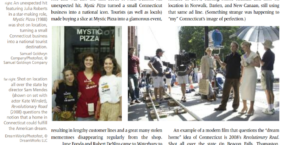
I moved to Connecticut in 1960, perhaps inspired by “my” movie Connecticut. Has all this location work destroyed the older, simpler image and spoiled things for me at the movies? Of course not. Connecticut was never alone in being turned into a Hollywood design concept. Think about Paris, where everyone wears a striped shirt and carries a baguette in a paper bag. Orthe Pacific Islands, with the population done up in sarongs and grass skirts and orchids tucked behind their ears. How many people besides me actually made a trip to Casablanca, hoping to find something like Rick’s Café Americain, only to find a fairly startling picture of poverty and disease? Movies set in Paris or the Pacific—and Casablanca—are still terrific to watch and “believe” in long after you grow up and know they aren’t real. And real places you visit that aren’t like the movies are still exciting, beautiful, and educational. “Connecticut” as a narrative space for the movies wasn’t exactly wrong. Stylish New Yorkers did drive up to Greenwich to get married. Wealthy city people did build weekend homes here. The state did become a suburban oasis in which typical Americans could raise their kids well. And the beautiful homes are really here. Although “dream homes” like the one in Mr. Blandings Builds His Dream House were not designed by architects, the Hollywood set designers who made them had been inspired by real homes. Because movies are so influential, these designs in turn inspired architects to create more of them. Today’s location scouts can find a “Connecticut type suburban home of the 1950s” or a “Connecticut-style colonial from the 1940s” because those homes do exist. They are a great tribute to set designers and decorators who knew what they were trying to say to American movie-goers: Connecticut is a great place to live!
No single movie has yet ever quite managed to capture all of Connecticut’s beauty, diversity, historical meaning, and modern pizzazz. Raise your hand out there if, like me, you moved here on the basis of Connecticut as a concept, only to find out that the reality was not what you expected, but somehow even better.
By the way, I live in an old house with a brick fireplace, hardwood floors, and a big kitchen. No telephone niche. Reality has its limitations.
